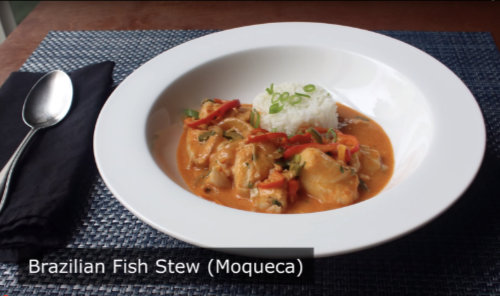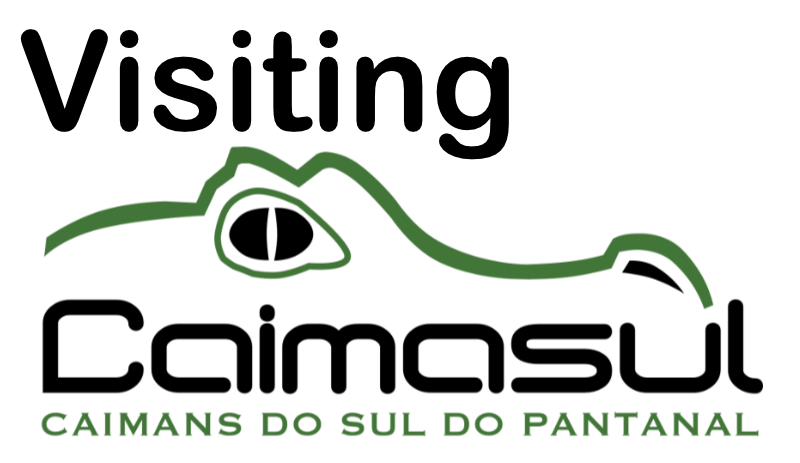

If you travel for 30 minutes out of Corumbá headed towards Porto Esperança and Campo Grande, you’ll pass Caimasul. From the road it’s an unassuming collection of buildings and circular tanks … but inside you’ll find one of the Pantanal’s most innovative businesses.
Hunting of caiman (known in Brazil as jacaré) for meat and leather is a tradition dating back centuries in the Pantanal. Sadly, this was a largely wasteful practice with only the tail (or around 15% of the animal) being consumed for meat – and only a few choice areas being usable for leather. However, the impact of this hunting on crocodilian populations was significant, with several Latin American species such as the Amazon’s Black Caiman (Melanosuchus niger) becoming endangered or nearing extinction.
If you travel for 30 minutes out of Corumbá headed towards Porto Esperança and Campo Grande, you’ll pass Caimasul. From the road it’s an unassuming collection of buildings and circular tanks … but inside you’ll find one of the Pantanal’s most innovative businesses.
Hunting of caiman (known in Brazil as jacaré) for meat and leather is a tradition dating back centuries in the Pantanal. Sadly, this was a largely wasteful practice with only the tail (or around 15% of the animal) being consumed for meat – and only a few choice areas being usable for leather. However, the impact of this hunting on crocodilian populations was significant, with several Latin American species such as the Amazon’s Black Caiman (Melanosuchus niger) becoming endangered or nearing extinction.
Even with its rich crocodilian population, some areas of the Pantanal were denuded of caiman – upsetting the natural balance and increasing the numbers of prey species such as piranha. Although hunting of caiman became illegal in the 1970s and 80s, large-scale poaching continued for some time afterwards, with smaller scale poaching still continuing even today.
Caimasul is helping change that. It supplies the market with farmed meat and leather which is produced in a sustainable way – while taking pressure off the wild population as it recovers. Importantly, Caimasul is also providing local riverside communities with a means to earn sustainable income in ways that incentivize them to value, preserve and closely monitor caiman populations within their region.
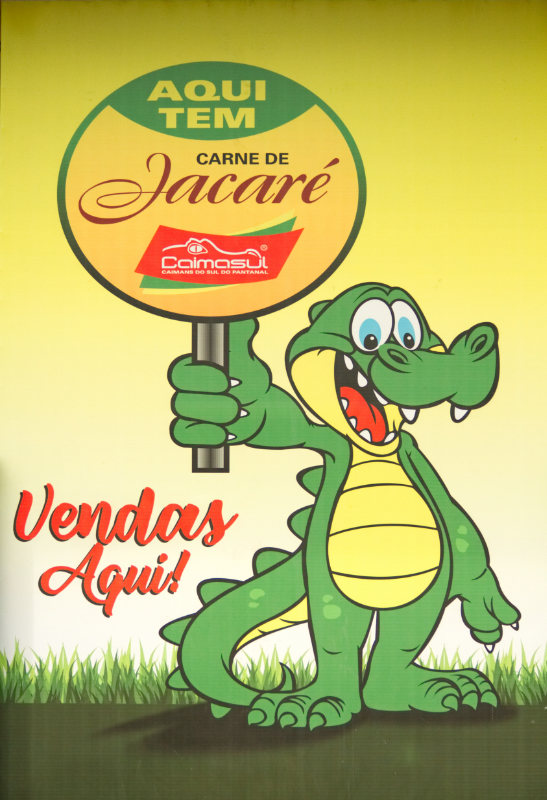
The Caimasul facility contains around 80 thousand caimans – including around 1,300 within a nearby breeding ponds. Most of the caiman are held in pens designed to mimic natural riverbanks where caimans are frequently found basking. These pens, and water inside them, are temperature controlled – ranging between 27°C and 30°C. Since sustainability is a major aim of the enterprise, water used within the facility is treated in settling ponds and then recycled.
Feed for the caiman comes from local abattoirs – several tonnes per day. The facility includes a feed processing plant where beef offcuts are mixed with supplements to produce a nutritionally-balanced and veterinary-approved feed that keeps the animals well-fed and healthy. The animals’ welfare is further ensured through ongoing monitoring and checks.
The Caimasul facility contains around 80 thousand caimans – including around 1,300 within a nearby breeding ponds. Most of the caiman are held in pens designed to mimic natural riverbanks where caimans are frequently found basking. These pens, and water inside them, are temperature controlled – ranging between 27°C and 30°C. Since sustainability is a major aim of the enterprise, water used within the facility is treated in settling ponds and then recycled.
Feed for the caiman comes from local abattoirs – several tonnes per day. The facility includes a feed processing plant where beef offcuts are mixed with supplements to produce a nutritionally-balanced and veterinary-approved feed that keeps the animals well-fed and healthy. The animals’ welfare is further ensured through ongoing monitoring and checks.
Collecting Caiman Eggs
The caimans are raised from eggs from Caimasul’s breeding facility, and from the surrounding Pantanal. The system implemented by Caimasul to collect eggs from the Pantanal is benefits both conservation and remote riverside communities. Riverside residents earn a sustainable income and are learning to value the caimans and protect their nesting sites. Collectors use a smartphone app to map nest sites, track the number of eggs harvested, eggs remaining (to ensure caiman numbers are maintained for future collections), and general condition of the nest site. This data gets fed back into a central database which is used for reporting to environmental agencies and for ongoing research.
Caimans nests are surprisingly hard to find – being nearly invisible in the tall grasses along the region’s rivers and wetlands. Female caimans deposit their eggs in mound-shaped nests made from mud and rotting vegetation, which helps maintain a near-constant temperature for the developing eggs. Each nest contains up to 50 eggs. Once located, the collectors need to exercise great care – ensuring they don’t accidentally step on other nests closeby, and that each egg is properly handled. Unlike birds’ eggs, caiman eggs can’t be rolled or turned since the embryo inside each egg attaches itself to eggshell membrane at its uppermost spot. This means that the correct orientation needs to be maintained throughout the collection and transport process to avoid accidentally detaching and killing the embryos. For this reason, each egg gets marked with a soft marker so there’s a visual indicator of which way around the egg needs to be positioned.
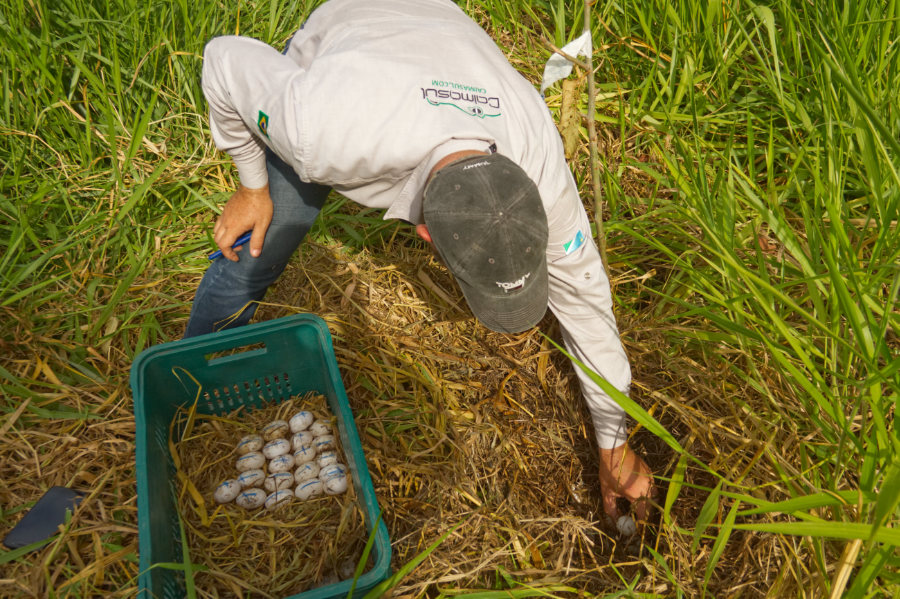
Above: Caimasul manager, Weber Girardi, collecting eggs from nests in the facility's breeding area. Each egg is carefully marked when collected to ensure its orientation is correctly maintained. Unlike birds' eggs, reptile eggs cannot be rolled or turned.
Below: Closer view of caiman eggs within a nest at the breeding facility.
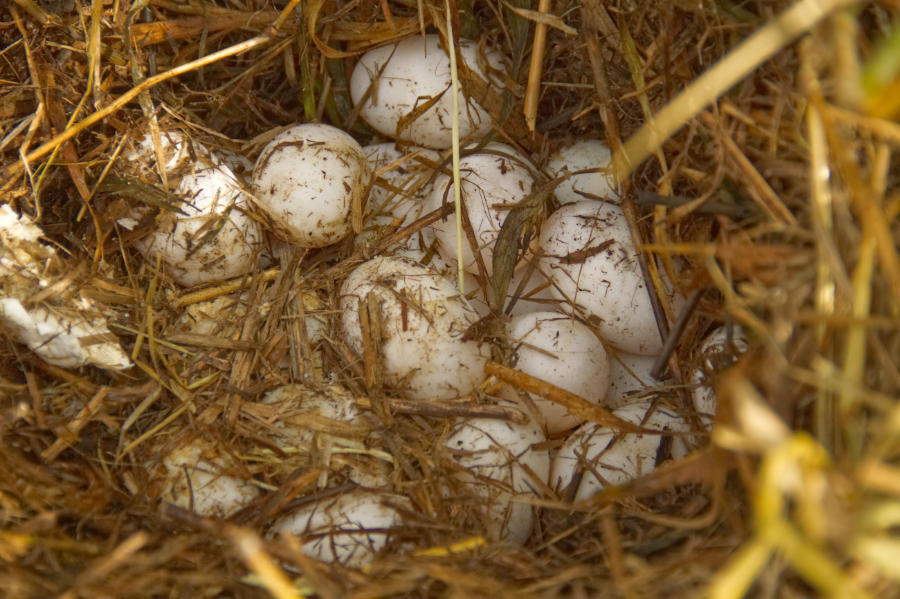
Caimasul has around 70 people working onsite in the processing plant, providing animal care, administration and maintaining the facility. Many more have been contracted in shorter-term roles or have benefited from purchases made within the local community during construction and subsequent operations. Other local families now earn income from the collection of eggs and protection of nesting sites - offering a viable alternative to traditionally more destructive economic practices such as fishing and cattle ranching.
Since it's beginning in 2016, Caimasul has become an important contributor to the community in and around Corumbá. It’s a clear example of how innovative thinking and businesses can provide an economic boost for the region. The jobs provided to local workers are important since (besides giving those workers a sense of pride and dignity) its helped them support their families through a very tough economic period for Brazil. Although the Pantanal is a great place for visitors, it also needs to be “great” for the people who live and work there. Caimasul's contribution is significant.
Caimasul has around 70 people working onsite in the processing plant, providing animal care, administration and maintaining the facility. Many more have been contracted in shorter-term roles or have benefited from purchases made within the local community during construction and subsequent operations. Other local families now earn income from the collection of eggs and protection of nesting sites - offering a viable alternative to traditionally more destructive economic practices such as fishing and cattle ranching.
Since it's beginning in 2016, Caimasul has become an important contributor to the community in and around Corumbá. It’s a clear example of how innovative thinking and businesses can provide an economic boost for the region. The jobs provided to local workers are important since (besides giving those workers a sense of pride and dignity) its helped them support their families through a very tough economic period for Brazil. Although the Pantanal is a great place for visitors, it also needs to be “great” for the people who live and work there. Caimasul's contribution is significant.
How does it taste?
Key questions remain: What is caiman meat like to eat, and should I be game enough to try it when visiting? In truth, caiman meat doesn’t have a particularly strong flavour or texture. Instead, it’s a healthy high-protein low-fat meat that can be substituted for chicken or fish in almost any recipe. We recommend trying it as we believe you’ll find it a pleasant culinary surprise, and because your purchase directly benefits local businesses and the community. Plus, if the meat comes from Caimasul you can be assured that it comes from sustainable and environmentally low-impact farming.
Spicy jacaré sausages (linguiça). Truthfully, we were a little unsure what to expect – but were very pleasantly surprised. The spices are reminiscent of strongly spiced Spanish Chorizo – except that caiman is a lighter white meat similar to chicken. Having it in sausages makes it easy to throw onto the BBQ. But in the hands of a skilled chef the end result can be truly amazing.
Real pantaneiros may think differently, but our personal favourite use of a jacaré filé is in a moqueca. Moqueca is Afro-Brazilian culinary specialty – being in essence a seafood stew, but flavoured using Dendê (Red Palm) Oil which was originally brought to Brazil by African slaves. Olive oil can be used as a substitute but lacks the flavour. The mixture is spiced with chilli and then softened with the addition of coconut milk. The overall effect is a like a mild Thai curry but with flavours that are uniquely Brazilian. The addition of caiman meat makes this dish even better.
Caiman Leather
Caiman leather is popular for boots and fashion accessories. Although alligators, crocodiles and caimans are closely related – the leathers differ considerably. In truth, caiman is the poor cousin of the family and not so highly regarded. This is because caiman leather is stiffer due to bony calcium deposits called “osteoderms” which makes the leather harder to work with. This stiffness also makes it less valuable for products needing softer or more supple leather. However, caiman leather is heavily textured which can give a more pleasing or exotic finish. For this reason, caiman leather is a popular choice for boots in Brazil, Mexico, and the United States.
If looking for a pair of caiman boots during your Pantanal stay, you’ll find a small selection in Campo Grande’s Mercadão Municipal or a bigger selection online at Reizinho Botas. Just remember that, for those boots to last a long time, the caiman leather needs to be regularly conditioned to help prevent it from drying and cracking.
Caiman leather is popular for boots and fashion accessories. Although alligators, crocodiles and caimans are closely related – the leathers differ considerably. In truth, caiman is the poor cousin of the family and not so highly regarded. This is because caiman leather is stiffer due to bony calcium deposits called “osteoderms” which makes the leather harder to work with. This stiffness also makes it less valuable for products needing softer or more supple leather. However, caiman leather is heavily textured which can give a more pleasing or exotic finish. For this reason, caiman leather is a popular choice for boots in Brazil, Mexico, and the United States.
If looking for a pair of caiman boots during your Pantanal stay, you’ll find a small selection in Campo Grande’s Mercadão Municipal or a bigger selection online at Reizinho Botas. Just remember that, for those boots to last a long time, the caiman leather needs to be regularly conditioned to help prevent it from drying and cracking.

Credits
Gualberto Becerra/Shutterstock. Caiman boots
